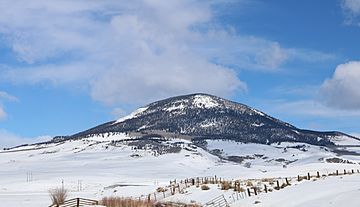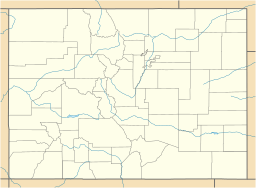Tomichi Dome facts for kids
Quick facts for kids Tomichi Dome |
|
|---|---|

Tomichi Dome viewed from U.S. Route 50
|
|
| Highest point | |
| Elevation | 11,471 ft (3,496 m) |
| Prominence | 2,325 ft (709 m) |
| Isolation | 10.74 mi (17.28 km) |
| Listing | Colorado prominent summits |
| Geography | |
| Location | Gunnison County, Colorado, U.S. |
| Parent range | Sawatch Range |
| Topo map | USGS 7.5' topographic map Doyleville, Colorado |
Tomichi Dome rises north of U.S. Highway 50 west of Hot Springs Creek and south of Waunita Hot Springs Reservoir in the southeast quarter of Gunnison County, Colorado. It is situated within the Gunnison National Forest.
Geology
Tomichi Dome is a prominent igneous mountain formed during the Tertiary. The predominate rock is rhyolite, but microgranite, breccia, and tuff have been cited as present. Surrounding the mountain, on the valley floor, is Mancos Shale, a Mesozoic sedimentary rock.
Tomchi Dome has been described as an intrusion and also as an extrusive, volcanic feature. As an intrusion, the pluton may have formed when magma was intruded into the Mancos Shale resulting in a laccolith. Given the fine-grained texture of the rock, the laccolith is assumed to have been at a shallow depth and cooled rapidly. Venting may have been associated with the intrusion resulting in the rhyolytic breccia and tuff documented in the vicinity. Shallow rhyolitic plutons southwest of Tomichi Dome, in the San Juan Mountains near Lake City, have also been described as laccoliths.
Alternatively, Tomichi Dome has been described as an extrusive, volcanic feature where the initial eruptions deposited breccia and tuff that is over 670 feet (200 m) thick. A flow or dome of topaz rhyolite overlies the tuff.
Whether plutonic or volcanic, Tomichi Dome is possibly one of a string of igneous structures associated with the Rio Grande Rift, which stretches from Mexico to Colorado.
Historical names
- Tomichi Dome – 1907
- Tumitche Dome


